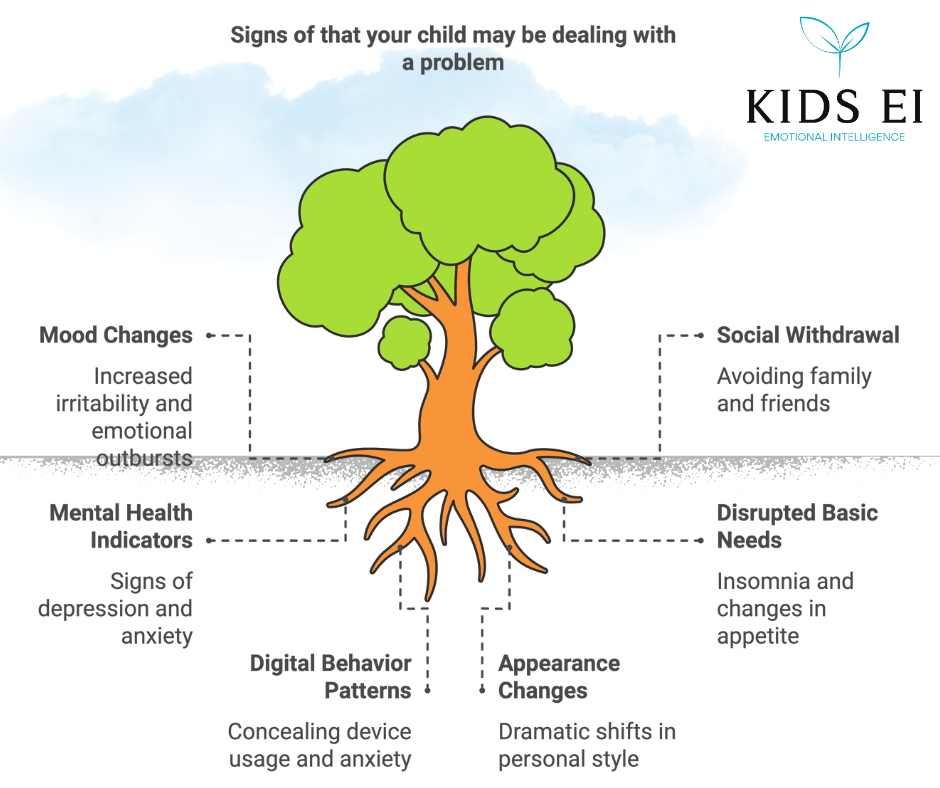Understanding Your Child's Digital Distress: A Parent's Guide to Warning Signs
In today’s hyperconnected world, children and teens are navigating complex digital landscapes, often without the life experience to fully process or manage the emotional challenges they may encounter online. For many parents, the signs of digital distress can be subtle or easily mistaken for typical growing pains or “just being a teenager”, making it difficult to discern when to step in. However, some behavioural patterns (both online and offline) can serve as key indicators that a child may be struggling with digital stress, peer pressure, or even cyberbullying.
This guide is designed to help parents recognize the early signs of digital distress, from mood changes and social withdrawal to physical symptoms and online behavioral shifts. By understanding these warning signs, parents can create a supportive environment that encourages open communication, digital safety, and healthy boundaries.
Emotional, psychological, physical and behavioural patterns that may indicate your child struggling with an online issue.
Emotional & Psychological Signs
Mood Shifts
Increased irritability beyond typical teenage fluctuations
Sudden, intense emotional outbursts (yelling, crying). Or sometimes just not being themselves.
Persistent need for reassurance
Episodes of unexplained anxiety or distress
Social Behavior
Withdrawal from family activities or social circles
Avoiding friends or isolating from usual social groups
Unpredictable behavior, from complete withdrawal to intense attention-seeking
Mental Health Indicators
Notable signs of depression or anxiety
Evidence of self-harm or risk-taking behaviors
Difficulty concentrating/focussing on daily tasks
Significant drops in self-esteem
Physical & Physiological Signs
Basic Needs
Disrupted sleep patterns, difficulty falling asleep, or insomnia
Changes in appetite, either loss or increase
Decline in personal hygiene
Physical Manifestations
Nervous habits, such as nail-biting or excessive fidgeting
Physical tics, visible tension, or restlessness
Changes to posture and body language
Appearance Changes
Sudden changes in clothing choices or personal style
Wearing more revealing or uncharacteristic outfits
New and heavy use of makeup or other self-presentation changes
Digital Behaviour Patterns
Device Habits
Hiding screens or using devices in private spaces
Anxiety or stress when notifications come in
Excessive, compulsive checking of phone or device
Online Activity
Clearing browsing history frequently
Installing new apps or accounts without explanation
Becoming defensive when asked about online activities
Noticeable increase in time spent online
Digital Footprint
Unexpected packages or online orders
New social media accounts or sudden changes in posting style
Unusual activity, such as multiple new subscriptions or transactions
Red Flags Requiring Immediate Attention
Urgent Warning Signs
Self-harm or discussion of self-harm
Extreme social isolation
Severe sleep disruption
Dramatic personality changes
Explicit signs of online exploitation
Clustering of signs
Pay particular attention when observing:
Multiple signs from different categories
Rapid onset of several symptoms
Persistent changes lasting more than two weeks
Signs that interfere with daily functioning
Action Steps for Parents
Documentation
Keep a detailed log of observed behaviors
Note dates, times, and any associated triggers
Document which apps or platforms seem to cause stress
Track patterns in behavior changes
Assessment Questions
Ask yourself:
Is this behaviour new or unusual?
How long has it been occurring?
What other changes have I noticed?
Is there a pattern to when these behaviours appear?
Response Levels
Level 1: Monitoring
Minor signs with minimal impact
ACTION: Observe closely, have gentle check-ins
Level 2: Active Response
Multiple signs persisting across areas
ACTION: Open conversations, provide supportive guidance
Level 3: Intervention
Severe signs impacting daily life
ACTION: Seek professional help promptly
When to Seek Additional Support
Reach out if you notice:
Consistent behavioral shifts
Persistent secrecy around online activities
Clear signs of harassment or distress due to technology
Resources to Consider:
School counselors
Digital safety experts
Family therapists
Online safety organizations
Remember
Behavioural changes don’t always signify a crisis. Look for patterns rather than isolated incidents, trust your instincts, and engage with empathy. Early, open communication is the best preventive tool, and ongoing support is far more impactful than a single conversation.
Note: This guide is meant for awareness and early detection. Always consult with healthcare professionals or counselors when concerned about your child's well-being.
Remember that these conversations aren't “do once and forget”. They're ongoing conversations that evolve as your child grows and technology changes. Your goal isn't to be the perfect digital parent but to be an approachable, informed, and supportive guide in your child's digital journey.
See you at the next blog where we will discuss all about chatting online and teaching your child about stranger danger in the online world.
References:
Internet safety for kids. (n.d.). Priory. https://www.priorygroup.com/private-camhs/internet-safety-for-kids?t
Department for Education, South Australia. Online Safety- What to do when your child has an online problem. https://www.education.sa.gov.au/parents-and-families/safety-and-wellbeing/bullying-and-cyberbullying/online-safety-support/online-safety-what-do-when-your-child-has-online-problem?t
Department for Education, South Australia. Cyberbullying- recognising the signs. https://www.education.sa.gov.au/parents-and-families/safety-and-wellbeing/bullying-and-cyberbullying/cyberbullying-support/cyberbullying-recognising-signs?t
E Guarnotta and S Gupta. 7 Signs That Your Child or Teen May Be Unsafe on Social Media. https://www.goodrx.com/health-topic/mental-health/social-media-safety-for-kids?t


